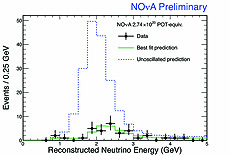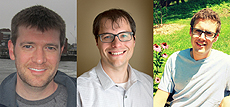Muon neutrinos make a disappearance
 |
| This plot shows the energy spectrum of detected muon neutrino events in the NOvA detector compared to the much larger signal that would be expected if there were no neutrino oscillations. |
Neutrinos are ghosts; everywhere around us, we unknowingly swim through billions of them constantly without ever interacting. Thankfully both natural and man-made sources such as the Fermilab NuMI beam produce copious numbers of higher-energy neutrinos. This abundance means that they can be spotted with very large detectors despite their ghostly nature. They come in three types and are known for their strange properties, such as their tendency to oscillate, or change from one type into another, similar to tossing a basketball and finding a mere ping pong ball where it lands.
Oscillations depend on a neutrino's energy and distance traveled, and by using a man-made neutrino beam we can carefully choose where we put our detectors in order to maximize this effect. This was done in NOvA, the U.S. flagship long-baseline neutrino experiment with a massive five-story, 14,000-ton far detector located in remote northern Minnesota, 500 miles from Fermilab, which only recently released the analysis results from its first batch of data.
NOvA looks for both the disappearance of muon type neutrinos (which make up the NuMI beam) as they oscillate away, and the appearance of electron type neutrinos that wouldn't be there without oscillations. The included plot shows the energy distribution of muon neutrinos detected, where NOvA would expect to see 201 muon neutrinos if there were no oscillations, but only 33 were actually seen — clear evidence of oscillations.
Muon neutrinos are detected by seeing muons resulting from their interactions, and one analysis challenge was to distinguish the muons from neutrinos from tens of millions of very similar looking cosmic ray muons. Only one or two of these 33 events are estimated to be cosmic rays surviving the sophisticated event selection, however.
The shape of the energy distribution contains further information that allows extraction of precise parameters detailing the inner workings of the oscillations. These NOvA results are already competitive with the world's best information on these parameters with less than 10 percent of the planned data, and this result will quickly improve.
The information gleaned from these rare neutrino interactions has far-reaching implications and can teach us about things like the evolution of the universe, how a supernova works and possibly even why the universe is made of matter and not antimatter. We still have a long way to go in solving all their mysteries, but NOvA is a big step along the path to understanding these little ghosts all around us.
—Kirk Bays, California Institute of Technology
 |
| This analysis is the subject of these physicists' Ph.D. theses. From left: Michael Baird (Indiana University), Nicholas Raddatz (University of Minnesota), Dominick Rocco (University of Minnesota). Not pictured: Susan Lein (University of Minnesota). |
|